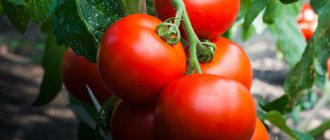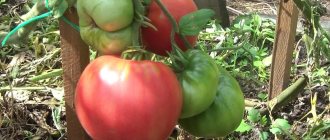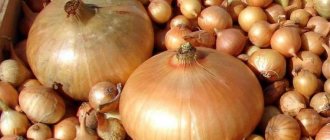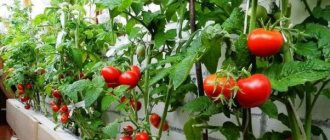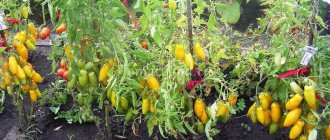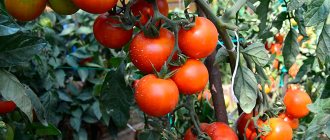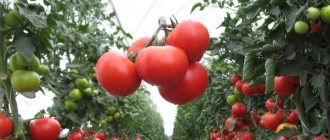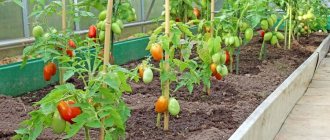MedovoeHobby.ru » Tomatoes » Tomato Slot - description, planting and care
0
160
Article rating
The mid-late tomato Slot F1 was bred by domestic breeders and included in the State Register in 1999. Previously, this crop was cultivated only in open ground, but now it is successfully cultivated in a greenhouse, and the harvest is just as abundant and tasty.
Brief information about the variety
- Fruits and bush:
tomatoes are round, massive (60-130 g). Determinate bushes, standard - 1-1.5 cm in height. - Productivity:
about 7 kg per bush, 28 kg per square meter. - Resistance:
resistant to verticillium, damaged by brown spot, powdery mildew. - Distribution:
in the Middle and Central zone - in a greenhouse, in the Krasnodar Territory, Crimea and Astrakhan region - in open ground. - Application:
consumed fresh, used for preparing salads, ketchup, juice, first and second courses, whole canning, pickling and pickling. - Planting:
seedling method of cultivation, transplanted into open ground at the end of May or early June, into a greenhouse - May 10-20, scheme - 50x40 cm (4 bushes per 1 m²). - Soil:
loose, fertile. - Care:
garter, shaping into 2 stems, watering, loosening, weeding, fertilizing 3 times a season. - Ripening period:
after 115-120 days.
Tomato fruits Slot: reviews and description
The fruits of Slot tomatoes are very beautiful. They have a regular round and slightly flattened shape. Usually in one batch of harvest all the tomatoes are the same shape and size.
With proper care, the fruits of Slot tomatoes grow juicy and large.
These tomatoes are quite small in size. The first harvest rarely reaches 90 g, and subsequent batches of tomatoes can weigh less than 50 g. This small fruit size is what attracts many gardeners.
The skin of these tomatoes is thin, but quite dense and shiny, and has a bright red color. This is a very transportable hybrid that has a good shelf life.
The Slot tastes sweet and sour. It contains only 4 percent dry matter and is therefore very juicy. Each fruit contains only 3 chambers with small seeds.
You will not be able to use seeds collected from ripe tomatoes of this variety last year. Since the results of repeated cultivation of hybrid seeds are unpredictable.
Such tomatoes can act as a complete side dish for meat or added to a salad. They will also be very tasty if processed into sauce, juice or added as an ingredient to a hot dish. According to gardeners, it is not worth preserving such fruits entirely, as if hot brine gets on their skin, it will simply crack.
general characteristics
The plant is standard, determinate, height - 1-1.5 m. Ripening occurs on the 115-120th day after transplanting the plants to the garden bed.
The yield is good - up to 7 kg of vegetables are harvested from one bush; per square meter you get up to 28 kg of fruit (when planting 4 bushes). One bunch produces 5-6 tomatoes. The subsequent harvest is smaller.
Tomatoes are grown in open ground in the Astrakhan region, Krasnodar region, and Crimea. In the Middle and Central zones they are cultivated in greenhouse conditions.
External description:
- Bushes of compact shape, medium branching and foliage.
- The stem is of medium thickness, covered with pinnately sectioned, light green, wrinkled leaves.
- The first fruit cluster develops above the 9-11th leaf, the next ones every 3 leaves.
- The tomatoes are red, round, smooth - weight 60-130 g. The surface is glossy, thin, but very durable, so they tolerate transportation well over long distances. There are 2-3 chambers inside.
The pulp is oily, of moderate density and juiciness, sweet with sourness. Dry substances - 4%. Not many seeds.
Vegetables are consumed fresh, canned whole, used for preparing first and second courses, snacks, salads, ketchup and juice. Beautiful and small fruits are suitable for pickling and pickling.
The opinion of summer residents regarding the “Slot” variety
More complete information about tomatoes is contained in the reviews. In them, summer residents share their experiences and give advice to beginners. They also express their own opinions.
- Arseny. Tomatoes have been planted for more than one year. They don't take much care of them. I really like the taste of fresh fruits.
- Angelina. Every year he always grows 5-6 tomato bushes on the plot. Almost everything is eaten. The remainder goes for processing.
- Marina. I didn't like the tomatoes. When fresh, the taste is very sour. During pickling, the skin burst, disrupting the structure of the fruit.
- Christina. He has been growing tomatoes for 5 years. For her, he is among the first among those required to board. I like it pickled and fresh. The characteristics are satisfactory. The only thing I don’t like is that you have to buy seeds every year.
- Valentina. I like the high yield of the plant. And 100% seed germination.
The unpretentious variety of tomatoes “Slot” has earned a good reputation among experienced summer residents. Many people recommend it to others, since their characteristics are only positive. And caring for him is no different from others.
See also
Description of the Parodist tomato variety, cultivation featuresRead
Growing seedlings
Deadlines
Tomatoes of the Slot f1 variety are grown in seedlings. The best time for sowing seeds is the first or second ten days of March. By the end of spring, the bushes will grow, become stronger and develop a good root system before planting on the site.
Preparing seeds and soil
You need to sow the seeds in loose, fertile and light soil. Typically, gardeners take store-bought substrate for growing vegetable seedlings. You can also prepare it yourself.
Mix garden soil with leaf compost, sawdust, ash and coarse sand in a ratio of 2:2:1:0.5:1.
First, the sawdust is poured with boiling water, then with a hot solution of urea (1 tablespoon of substance per 1 liter).
You can purchase seeds online or in a specialty store. Buy fresh material with a current expiration date. To get strong shoots, the seeds should be immersed in salt water for 15 minutes.
Seeds that have sunk to the bottom are suitable for germination. Then they are washed, dipped in a solution of potassium permanganate for 20 minutes, and then irrigated with Zircon or Epin.
To quickly hatch, the seed is laid out on a damp cloth, wrapped and placed in the refrigerator for a day.
Sowing technique
Take seedling boxes and plastic containers with holes in the bottom. A little expanded clay is poured onto the bottom. Then fill it halfway with fertile substrate.
Sow the seeds in furrows to a depth of 1-1.5 cm at a distance of 3-4 cm. Sprinkle with earth, lightly compact, and spray with warm water.
Many gardeners grow seedlings in disposable containers to avoid picking in the future. Plastic cups or peat tablets are suitable for this. Place 2 seeds in each pot. As it grows, the thin and weak sprout is removed.
Crop care
Seedlings need to be covered with transparent film or glass, creating a greenhouse microclimate. The best place to keep it is a warm window sill with access to diffused daylight. The optimal duration of a day is 10 hours. On cloudy days, you can use artificial lighting.
The crops are ventilated every day, moistened if necessary, and the temperature is maintained within 23-25°C.
As soon as shoots appear on the surface of the substrate, the shelter is removed and the temperature is lowered to 16-18°C. This will prevent the sprouts from stretching. The tomatoes continue to be watered, the soil is carefully loosened, and weak and yellowed sprouts are removed.
Picking
When growing in groups in a large container, tomatoes need to be picked. The first procedure is carried out at the stage of appearance of 3 true leaves. Take 50 ml disposable cups with holes in the bottom.
The seedlings are watered abundantly, then removed and, together with the soil, transferred separately into a planting container. Add soil, compact it, moisten it, spray it with Epin or Zircon.
The second pick must be carried out 21 after the first procedure. The technology is the same, only they take pots 1-2 cm in diameter larger than the previous ones.
In order for the seedlings to quickly adapt and begin to grow, they are watered with a solution of urea or ammonium nitrate. 15 g of the substance is dissolved in 10 liters of water. Consumption per seedling - 50 ml.
How to care
Since the plant is powerful, it requires a lot of attention, you will have to:
- regular and abundant soil moisture;
- frequent feeding;
- tying hands;
removing excess leaves; annual pruning of branches after harvesting to stimulate the growth of new fruit-bearing shoots; rejuvenating pruning of an adult plant in spring.
The plant produces a lot of lashes, so trellises are installed to support them. Many gardeners weld structures (net trellises) from rods and tie the crown of a tree to them, like grapes.
The crop is propagated by vegetative methods. To do this, cut cuttings from a 1-2 year old plant with a diameter of 1 cm and a length of up to 50 cm. In the spring, they are placed in water to form roots, then planted in the ground. The grown cuttings will bear fruit in the first year of life. A large number of seedlings can be prepared from cuttings. Cuttings cut in the fall after the formation of roots can be planted in pots and monitor the development of the bushes in your home all winter. The strongest sprouts, 15-30 cm high, with 5-7 leaves, are planted in open ground. They are planted at a distance of 1.5 - 2 m. If there is no trellis, then stakes up to 2 meters high are driven in to support the bush when planting nearby. To prevent diseases, the roots of the plant are treated with water with iodine: for 1 bucket of water - 1 bottle of iodine from the pharmacy.
How and when to transplant to a permanent place
Approximately 50-60 days from the moment of sowing the seeds, the seedlings can be planted in the garden bed. They are transplanted into the greenhouse on May 10-20, into open ground - in late May or early June.
Before planting, tomatoes must undergo adaptation to fresh air. 10 days before planting, they are taken outside for several hours, and on the last day they are left to spend the night.
The site has been prepared since the fall. Choose a bed where cabbage, pumpkin crops, carrots, onions and beets previously grew. They remove garden waste, add a bucket of compost or last year's manure, 3 kg of wood ash, 100 g of superphosphate and 45 g of potassium sulfate, dig it up, and level it.
A week before planting the bushes, the soil is spilled with a urea solution - 15 per 10 liters of water. This product destroys all pathogenic microflora in the soil.
Dig holes according to the pattern - 50x40 cm (4 bushes per 1 m²). They moisten, transfer the seedlings along with a lump of earth, sprinkle with soil, compact, and water. To retain moisture, mulch with garden soil.
Preparatory work before planting seedlings in the ground
While the seedlings are growing and getting stronger at home, it is necessary to prepare a bed where the tomatoes will grow. Tomato, like any other crop, has its own requirements for growing conditions.
Choosing a landing site
Tomatoes love the sun, so for planting them you need to choose an open, well-lit area. If water stagnates in the area intended for tomatoes, the soil must be drained or raised beds must be built.
This vegetable cannot be planted for 2 years in a row in the same place, the crop will get sick.
Favorable predecessors will be:
- cucumbers;
- carrot;
- beans;
- peas;
- cabbage;
- onion.
Preparing the beds
Tomatoes like soil with a neutral or slightly acidic reaction. A simple test with litmus paper will help determine the acidity level.
The growing weeds will also give a clue. If buttercups and sorrel predominate in the area, then the soil is acidic.
The ideal soil structure for growing tomatoes is chernozem. All other lands must be improved using additional components.
If the bed is located on sandy loam, loam or clay soil, you will need to add peat, compost, humus or sapropel in the amount of 5-7 kg per 1 sq. m. m.
River sand or sawdust is added to heavy soil (clay or loam) to make it loose.
In the fall, at the beginning of October, the soil is dug up to a depth of 25-30 cm, while adding all the necessary components and fertilizers. Now the tomato plot is ready for wintering. In spring, the soil is loosened, disinfected and mineral fertilizer, such as ammonium sulfate, is applied.
Depending on the region, ridges are formed at the beginning or end of May, before planting seedlings. To do this, dig shallow trenches with sides 5 cm high, located from north to south. If there are several beds, leave a distance of 1 m between them.
The row spacing should be 70 cm wide. Each bed can be divided into sections measuring 50x50 cm, dividing them with sides. This breakdown is convenient because the water after watering will not spread beyond the plantings.
Features of care
In the first 10 days, Slot f1 tomatoes growing in open ground need to be shaded from the scorching sun and covered with film at night so that they do not freeze.
Watering
For 2 weeks, the transplanted tomatoes are watered daily so that they take root faster. Further watering depends on the condition of the soil - moisten it after it dries to a depth of 4-5 cm. Bushes experience an increased need for moisture during the period of vigorous flowering and fruiting. The optimal frequency of watering at this time is every 3 days. Water is poured under the root, avoiding contact with the stem and leaves.
To prevent a crust from forming on the surface of the soil, the next day after moistening, it is loosened, also weeded between the rows, and weeds are removed.
Feeding
At each stage of growth, tomatoes require different feedings.
| Deadlines | Drugs | Dosage |
| 10 days after planting in the garden | Ammonium nitrate, Nitrophoska, Urea | 15 g per 10 liters of water. Consumption per bush - 500 ml |
| During the flowering period | Superphosphate and potassium sulfate | 1 tbsp. l. on a bucket of water. For one plant - 0.5 l. |
| At the stage of fruit filling | A solution of potassium sulfate and superphosphate | 15 g per 10 liters of water. 0.7 l per bush |
Fertilizing is combined with watering so that the plants do not get burned and quickly absorb useful microelements.
Shaping and garter
To get a large and tasty harvest, you need to carry out the correct formation - into two stems. Wait until the first flower cluster with a side shoot appears, after which all the stepsons and leaves in the lower part of the bush are torn off. To prevent the development of new shoots, stepchildren pluck out the stump. The procedure is carried out early in the morning, by the evening the wounds have time to heal.
In addition to shaping, the Slot f1 tomato requires periodic garter. As they grow, the bushes are tied to a stake or trellis. This will protect the stems from breaking off under the weight of the fruit.
Planting and caring for the plant
They are grown only by seedlings. Seeds are planted in containers in March. You can add a little wood ash to the soil mixture. It contains potassium and phosphorus, which are necessary for young growing tomatoes.
Then, after the appearance of 2 full leaves, they are picked. It is important to timely fertilize the plants. This is done in order to give more strength to the young plant.
After planting in the ground, it forms 1–2 trunks. All excess stepsons are cut off. There is no need to remove the growth point. The plant regulates its height independently. There are up to 4 bushes per 1 m2.
The plant needs a garter due to the large number of fruits on them. To avoid breaking branches, it is better to secure it on supports in a timely manner.
Protection from diseases and pests
The description of the tomato Slot f1 indicates frequent damage by brown spot, mainly in the southern regions when grown in unprotected soil. To cope with the disease, it is necessary to treat the bed with Zaslon, also reduce watering and loosen the soil more often.
When planted in the middle zone, tomatoes suffer from powdery mildew. Fungal infection is treated with Profi Gold.
Among the pests, the Colorado potato beetle can be a nuisance. The drug Prestige will help destroy it. Bison is used against rusty mites, and Thunder saves from mole crickets.
To protect tomatoes from the invasion of harmful insects and diseases, it is important to follow several rules:
- do not allow plantings to become dense;
- provide complete care - regularly remove weeds from the garden beds, weed the rows, loosen the soil;
- systematically water and fertilize;
- Between the rows you can plant plants that repel parasites - marigolds, mint, parsley, onions.
Tomato varietal characteristics Slot F1
Tomato Slot is the optimal combination of good taste, endurance and excellent fruiting. This hybrid variety of tomatoes has long been enjoyed by many lovers of growing vegetables in their gardens.
Tomato varietal characteristics Slot f1
Brief information about the variety
- Fruits and bush : tomatoes are red, slightly flattened, weighing from 100 to 150 g. The bush is semi-determinate, (height up to 120 cm).
- Productivity : high yielding.
- Resistance : cold-resistant, resistant to diseases and pests, but it is advisable to treat plants for prevention when planting seedlings, at the stage of flowering and fruiting.
- Distribution : In the southern regions of the country, tomatoes show high yield levels. In the middle zone they are recommended to be grown in a greenhouse.
- Application : fresh and for preservation.
- Planting : seedling method - seedlings are transplanted into open ground, depending on the region, from late April to mid-May. Planting scheme – 4 plants per 1 m².
- Soil : there are no special requirements for the soil, the main thing is that it is light, air- and water-permeable.
- Care : fertilizing is carried out at the growth stage; a complex composition with potassium and phosphorus is required. Water regularly as the soil dries. Stepping and forming a bush is a must.
- Ripening period : the first fruits ripen 90-100 days after emergence. It is possible to store tomatoes for 20 days.
Characteristics of the variety
Slot tomatoes are an early tomato variety.
Description of the bush
The bushes are quite tall and grow up to 100-120 cm. There is no need to pinch the tops: their growth stops on their own. Branched bushes. They grow well both in greenhouses and in open beds.
To get a sufficient number of fruits, the plant needs to be pinched. Usually the bush of the Slot F1 variety is formed into 1-2 stems. Excess shoots should be removed near the root. If this is not done, then the plant simply cannot cope with the nutrition of all the fruits that have set and they will die. The remaining stems of the bush need staking.
Tatyana Orlova (Vasilidchenko) (candidate of agricultural sciences):
If you do not prun the tomato plant, then no death will occur. The fruits just won’t have time to ripen (in cold regions) or will be small.
Description of fruits
The size of the fruits is average, their weight ranges from 100 to 150 g. Tomatoes that ripened on the lower clusters have a larger mass, and fruits collected from the top weigh less. According to the characteristics, tomatoes have a juicy red color and a round, slightly flattened shape.
The taste of the fruit is very pleasant, with a slight sourness. Although the skin of tomatoes is thin, it does not crack.
Productivity
Gardeners note that under favorable weather conditions and following all the rules of agricultural technology, it is quite possible to get up to 10-11 kg of fruit from one tomato bush, which is a good characteristic of the variety.
In protected ground you can get about 15 kg of fruit. The dense arrangement of tomatoes in the garden negatively affects the yield: the plants do not have enough space for normal development. Therefore, the recommended planting density is 4 pcs. per 1 m² of land.
Application area
Tomatoes of the Slot variety can be used both for canning and for fresh consumption. They are juicy and meaty. They make salads, side dishes and many other dishes.
Housewives prepare delicious juices, sauces, ketchups from tomatoes, and add them to hot dishes. The description states that the tomatoes are well transported.
Advantages and disadvantages
The positive characteristics of the variety include:
- the plant tolerates temperature changes well;
- bears fruit well;
- easy to care for;
- tomato bushes are resistant to hot, dry weather.
If we talk about the disadvantages of the variety, we should mention the need to garter the bushes, which takes time, and the fact that without fertilizing with mineral fertilizers the fruits turn out small.
Growing
Tomatoes are easy to care for
Tomatoes Slot F1, like most other varieties of tomatoes, should be grown using seedlings. Before sowing, it is recommended to treat the seeds with a weak solution of potassium permanganate and a growth stimulant.
Treated seeds are sown in suitable containers. The quality and hardening of the sprouts subsequently influence the beginning of flowering and, accordingly, the ripening of tomatoes.
Landing
According to the description, seedlings can be planted in protected soil at any time in the spring, and young plants should be transferred to open soil only when the night frosts have finally gone away.
When planting, you should immediately take care of supports for the bushes and place stakes next to the holes for tying up the stems. It is also advisable to prepare the soil in advance and fertilize it with wood ash and humus.
Tatyana Orlova (Vasilidchenko) (candidate of agricultural sciences):
Soil preparation begins in the fall. It is dug deeply with the application and incorporation of organic and mineral fertilizers. For 1 sq. meter requires at least 5-6 kg of rotted manure or compost and 50-100 g of phosphorus and potassium fertilizers.
Tomato bushes need pinching. The plant should have no more than 2 stems.
Watering
It is advisable to water tomato bushes growing outdoors every day (in the morning or evening). In the future, the frequency of watering should be gradually reduced.
Tatyana Orlova (Vasilidchenko) (candidate of agricultural sciences):
On hot days, tomatoes are watered 2-3 times a week, on cool days - once every 7-10 days, spending at least 5-6 liters of water per adult plant.
Feeding
At the growth stage of tomatoes, they need mineral fertilizers containing nitrogen. During the flowering phase, tomatoes are fed with phosphorus-potassium fertilizers. At the fruiting stage, potassium sulfate is added.
Fertilizers must be applied correctly to prevent oversaturation of the soil with nutrients.
Disease and pest control
Tomato Slot is generally resistant to common diseases and pests, but you should not wait for possible problems to appear. To avoid damage to plants, it is better to carry out several preventive treatments of bushes against brown spot, powdery mildew, Colorado potato beetle and aphids.
According to the description of the variety, the plant is immune to tobacco mosaic, bacterial black spot and macrosporiosis.
Reviews from gardeners
A description of the requirements for care and cultivation, as well as reviews from gardeners who have already tried to plant this variety of tomatoes, indicate that the Slot hybrid compares favorably with other tomato varieties in many characteristics
Mistakes of summer residents
There are several most common mistakes that gardeners make when growing this crop, which results in a meager and not so tasty harvest:
- sowing infected or expired seeds, due to which the seedlings are weak, the seedlings stretch out, turn yellow and die;
- dense plantings - tomatoes grow, bloom and bear fruit poorly in crowded conditions;
- excessive watering with cold water leads to rotting of the stem, and the bushes dry out from lack of moisture;
- too frequent fertilizing with nitrogenous preparations, which inhibits the process of flowering and ovary formation;
- neglect of the bed - in weed thickets, tomatoes begin to get sick and are affected by various pests;
- improper formation of the bush, which makes the harvest smaller and less abundant.
Advantages and disadvantages
Tomato Peter 1: characteristics and description of the variety
The Slot tomato has several main advantages:
- gives a good harvest in a small area,
- tasty fruits that are well transported,
- drought-resistant and disease-resistant,
- frost-resistant and does not get sick due to temperature changes.
Important. However, he also has negative traits. At the initial stage of development, you will have to tinker with it a little more than with other varieties of tomatoes, since it is demanding when it comes to feeding.
Either way, if you need a variety that is weather-resistant and suitable for pickling, Slot is an excellent choice.
0 0 votes
Article rating
Reviews
According to many gardeners, the Slot hybrid is one of the best for growing in our country:
- if you follow all the rules of agricultural technology, you can get a rich harvest of beautiful tomatoes;
- it can be grown in greenhouse conditions, this is important for gardeners in cold zones, and the harvest is as tasty and plentiful as when planted in an open garden bed;
- tomatoes tolerate transportation well, last a long time and are intended for universal use.
Positive and negative sides
The presence of a large number of negative characteristics discourages the desire to purchase seeds for your plot. But Slot tomatoes have virtually no downsides.
Pros:
- Resistant to the vagaries of nature (in particular heat).
- Very productive.
- The taste is excellent.
- Tolerates lack of moisture well.
Minuses:
- Seeds collected from fruits are not suitable for independent propagation.
- At the growth stage, tomatoes are capricious regarding feeding.
Rules for choosing a variety
The name of the Nepas variety comes from the word nepasynkuyuschiy, which plays an important role in the process of growing tomatoes and caring for them
When planting tomatoes, everyone decides on the choice of variety based on their needs: some care about taste, others pay attention to size and shape.
When choosing a subspecies from this series (they all have different characteristics), you need to consider some factors:
- size. Those for whom the large weight of the fruit is important should take Nepas 14, 12, 10, 7. All other varieties are either cocktail or cherry;
- taste. Almost all subspecies have the sourness characteristic of this variety, but the taste does not suffer from this;
- fruit color. It is different for all varieties. Usually the seed packet shows the approximate shade of the tomatoes;
- type of bush. The variety is non-sapling, standard, as a result of which the plant height is small - from 40 to 80 cm (depending on the variety);
- resistance to diseases. Tomatoes of the Nepas series are hybrid, therefore they have good immunity;
- growing conditions. The variety is determinant, adapted to temperature fluctuations, and can grow in open ground. Not afraid of direct sunlight and cold (develops well at 18-20 °C).
Composition of tomato fruits[edit | edit code]
Top view, vertical and horizontal sections
Tomato fruits are distinguished by high nutritional, taste and dietary qualities. The calorie content of ripe fruits (energy value) is 19 kcal. They contain 4.5-8.1% dry matter, half of which is sugar, mainly glucose and fructose, as well as organic acids (3.5-8.5%), fiber (0.87-1.7% ). The fruits also contain proteins (0.6–1.1%), pectin (up to 0.3%), starch (0.07–0.3%), and minerals (0.6%). Tomato fruits contain a high content of carotenoids (phytoene, neurosporin, lycopene, non-alicopine, carotene (0.8-1.2 mg/100 g wet weight), lycosanthin, lycophyllum), vitamins (B1, B2, B3, B5), folic and ascorbic acid (15-45 mg/100 g wet weight), organic (citric, malic, oxalic, tartaric, succinic, glycolic), high-molecular fatty (palmitic, stearic, linoleic) and phenolcarboxylic (p-coumaric, caffeic, ferulic) acids . Anthocyanins, stearins, triterpene saponins, and abscisic acid are found in the fruits.
The choline present in tomatoes lowers cholesterol in the blood, prevents fatty degeneration of the liver, increases the body’s immune properties, and promotes the formation of hemoglobin [ source not specified 1507 days
]. The flavonoid naringenin, which has an anti-inflammatory effect, was found in the skin of tomatoes.
Content of trace elements in 1 kg of fruit: sodium - 40 mg, potassium - 2680 mg, calcium - 110 mg, magnesium - 120 mg, iron - 6 mg, copper - 0.97 mg, phosphorus - 270 mg, sulfur - 140 mg, chlorine - 400 mg, manganese - 1.89 mg.
How to determine the best tomato varieties for planting
Rating the best tomatoes is not so easy. Indeed, today there are more than 7.5 thousand types of these vegetables, and every year there are more and more varieties and hybrids of tomatoes.
To understand which tomatoes are better, you first need to decide what requirements are put forward for tomatoes. For example, it could be ten:
- the earliest tomatoes;
- suitable for open ground;
- grown in greenhouses;
- characterized by unusual characteristics (non-standard color, shape, taste);
- new breeding developments in 2022;
- varieties proven over the years and so on.
Let's start landing
First of all, you need to thoroughly moisten the soil in pots or boxes with seedlings. This will help you easily remove them from the seed container and prevent accidental damage to the root system.
Prepared holes for growing tomatoes in open ground should have a depth of 10-15 cm.
We water them (a bucket of water for 8-10 holes) and apply mineral fertilizers mixed with humus (proportion 1x3).
- Turn the container with the seedlings over, wrap your middle and index fingers around the tomato stem and remove it from the container.
- Tear off the leaves of the seedlings, leaving only 2-3 leaves on top (this will stimulate root growth).
- Place the plant with a ball of root soil vertically in the hole and sprinkle with compost. In this case, the tomato stem should remain open. Only the roots or soil pot are placed in the ground.
- Press the soil firmly around the plant and cover the compost with dry soil.
- After planting, mulch the soil (cut, slightly wilted grass, sawdust, straw or newspaper leaves are suitable for this). The mulch layer should be about 10 cm high.
When planting tomatoes in the ground is finished, we will leave them alone for 8-10 days. During this period, the plants take root and become accustomed to the new location.
There is no need to water them yet. But you need to be prepared for frost. To do this, immediately after planting, we will cover our young tomatoes with transparent film.
It will remain until the threat of frost disappears (for the middle zone this usually happens by June 5-10). You can make holes in the film with a diameter of 10 cm. This will reduce the risk of late blight infection.
After 10 days, we water the seedlings and at the same time plant a new one in place of the dead one. The first hilling when growing tomatoes in open ground can be done two weeks after planting the seedlings.
In the future, we will hill up the plants as they grow.
Landing
Growing this tomato is not fundamentally different from growing other varieties of tomatoes. Seeds for seedlings are planted approximately 2 months before planting the plants in open ground or under film cover.
Prepare the container. These can be wooden boxes, cut milk cartons, peat pots or cassettes. Fill them with prepared soil and press it down lightly. Use a match or toothpick to make grooves along the top of the soil. Their depth should be approximately 1 cm, the width between the rows should be 4 centimeters. Every one and a half to two centimeters, place seeds in the grooves and sprinkle them with soil. You can make it simpler: lay the seeds on the ground and cover them with a centimeter layer of soil.
Water carefully and cover the container with glass or film to create high humidity for sowing. Place the boxes in a warm place
Growing seedlings
In the first half of spring, natural light may not be enough for seedlings. Therefore, it is recommended to compensate for the lack of light using fluorescent lamps. Some gardeners illuminate young plants around the clock for the first two or three days after germination.
Seedlings need high humidity. Therefore, at first, the glass or film only needs to be opened slightly to give the sprouts access to fresh air. The cover can be completely removed after 10-25 days. High humidity does not mean watering every day. It is necessary to ensure that the soil is moderately moist. The swamp cannot be cultivated, otherwise the plants may die. Plants need to be watered under the stem. It is very convenient to use a syringe or pipette for this.
When daylight hours increase and plants begin to grow, the soil drains faster
Therefore, during this period it is very important not to skip watering.
Tomato seedlings need to be fed two to three weeks after the first shoots. Subsequently, fertilizers must be applied weekly. Ideally, it is better to use natural fertilizers made from humus or grass. From factory ones, you can use special humic fertilizers, vermicompost, etc.
Landing in the ground
Gladiator F1 is a tall plant, with an abundance of side shoots and fruiting clusters. Therefore, the distance between plants in open ground or in a greenhouse should be at least 40 cm.
It is better to plant seedlings in a permanent place on a cloudy and windless day. If the weather is hot and sunny, start work in the evening, at sunset. Each plant is planted with the stem buried 3-4 cm. The tomato will give additional roots in this area, which will make it stronger. After planting, water each bush with warm water.
If the planting of seedlings coincides with hot sunny days, it is better to cover the plants from direct sunlight for the first time. Old buckets without a bottom are quite suitable for this. You can also provide shade with tree branches stuck into the ground from the sunny side.
Preparing to sow seeds
The timing of planting tomatoes (sowing seeds) depends on how many days pass from sowing to the ripening of the fruit:
- early varieties - 100-120 days;
- mid-season varieties - 110-130 days;
- late-ripening varieties - 130-140 days.
In the central regions of Russia they are sown from mid-March to early April, in the southern regions you can start in mid-March, and in the northern regions and Siberia it is better to wait until mid-April. It is necessary to expect that, on average, at least 2 months should pass from planting seeds to planting seedlings in a greenhouse or open ground. Let's look at how tomato seeds are prepared for planting.
Soil preparation
The soil for seeds should be light, well absorbent and retain moisture, without bacteria and fungal spores. It's better to do it yourself.
- Mix garden soil with sand and peat in the following proportion: 2 parts soil, one part each sand and peat.
- Spill with boiling water, a solution of potassium permanganate (2%) or Fitosporin-M for disinfection, or calcinate the mixture in the oven.
- The garden soil is cleared of larvae and weeds.
Seed preparation
There are raw and processed (granulated) tomato seeds on sale.
Non-granulated seeds are prepared for sowing in the following way:
- Disinfect for half an hour in a solution of potassium permanganate (2%) or 2 hours in a solution of Fitosporin-M (half a teaspoon per 100 ml of water).
- Wash with water at room temperature and dry.
- Place on a cloth moistened with water or any growth stimulant, for example, aloe juice (dissolved in water 1:1), cover with the same wet cloth and place in a container with a lid.
- Place in a warm place and ventilate periodically.
- After the seeds hatch (usually on the 3-5th day), they are sown in the ground.
How to prepare for sowing
Preparatory work is a serious stage that cannot be neglected. It is necessary to prepare both seeds, soil, and planting containers.
With seeds there are two options for the development of events.
1. Option one – purchased seeds processed by the manufacturer. In this case, if the seeds are impregnated with any disinfecting or stimulating composition, enclosed in a capsule or hard shell, they do not need to be prepared for sowing. Information about this must be indicated on the packaging.
Tomato seeds
2. Option two - you collected the seeds yourself (took them from someone) or bought them packaged, and there are no instructions on the bag, but in appearance the seeds look quite normal. They need to be prepared.
Self-collected seeds
Both pots and soil must be disinfected in both cases.
The easiest way to disinfect pots is with soda, soap or potassium permanganate solution. It can be kept hot for greater effectiveness.
Potassium permanganate solution for disinfection
For soil disinfection, the most suitable method is also to pour a hot solution of potassium permanganate through it. To do this, place the soil in a colander or something similar. You can do without potassium permanganate by heating the soil, filled with water, in a microwave or oven, or freezing it in the freezer.
What is the best way to disinfect the soil?
Composition of soil for tomato seedlings:
- turf soil - 1 part;
- peat – 1 part;
- river sand – 1 part;
- superphosphate – 1 tbsp. for 10 liters of soil;
- ash – 4 tbsp. per 10 liters of soil.
Seed disinfection
There are many ways to disinfect tomato seeds. Here are the most popular ones.
- Potassium permanganate, one percent solution. Seeds, wrapped in a cotton cloth or gauze, are kept in a warm disinfectant for 20 minutes. Then washed.
- Aloe juice. This method helps not only to disinfect the seeds, but also to stimulate their germination. The juice should be from the stems, cut ahead of time, two weeks before soaking, and placed in the refrigerator. The seeds need to be kept in the juice for 12 hours.
- Fitosporin. One percent solution. The seeds are kept in it for an hour.
Harvest and storage
According to gardeners, the harvest ripens at the end of July, but the first tomatoes can be picked earlier. Fruiting lasts until mid-autumn, but it is better to harvest tomatoes at the end of September. When temperatures drop, tomatoes can become sick and spoil. It is recommended to pick them brown and then ripen them at home.
Due to the large size of the fruit, the shelf life of this variety is average. Fully ripened tomatoes are best stored in the refrigerator for no more than a week. Brown unripe fruits lie for about a month in a cool, dry place.
Tomatoes of Siberian selection. Heavyweights Nobleman and Superbomb
tomato Superbomb and hybrid Stesha F 1.the best varieties of tomatoes
Stesha and Superbomb tomatoes .June 18 brief review
